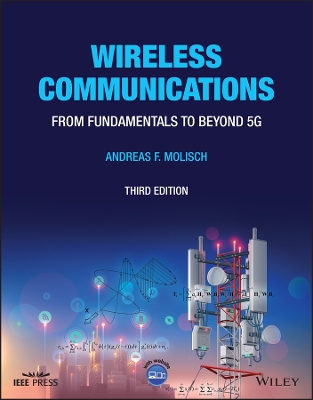Wiley - IEEE
1 primary work • 2 total works
Book 35
Topics featured include: wireless propagation channels, transceivers and signal processing, multiple access and advanced transceiver schemes, and standardised wireless systems.* Combines mathematical descriptions with intuitive explanations of the physical facts, enabling readers to acquire a deep understanding of the subject.* Includes new chapters on cognitive radio, cooperative communications and relaying, video coding, 3GPP Long Term Evolution, and WiMax; plus significant new sections on multi-user MIMO, 802.11n, and information theory.* Companion website featuring: supplementary material on 'DECT', solutions manual and presentation slides for instructors, appendices, list of abbreviations and other useful resources.
An authoritative and comprehensive treatment of wireless communication technology ranging from the fundamentals to the newest research results
In the expanded and completely revised Third Edition of Wireless Communications, distinguished researcher Dr. Andreas F. Molisch delivers an essential text in wireless communication technology that combines mathematical descriptions with intuitive explanations of the physical facts that enable readers to acquire a deep understanding of the subject.
This latest edition includes brand-new sections on cutting edge research topics such as massive MIMO, polar codes, heterogeneous networks, non-orthogonal multiple access, as well as 5G cellular standards, WiFi 6, and Bluetooth Low Energy. Together with the re-designed descriptions of fundamentals such as fading, OFDM, and multiple access, it provides a thorough treatment of all the technologies that underlie fifth-generation and beyond systems. A complimentary companion website provides readers with a wealth of old and new material, including instructor resources available upon request.
Readers will also find:
- A thorough introduction to the applications and requirements of modern wireless services, including video streaming, virtual reality, and Internet of Things.
- Comprehensive explorations of wireless propagation mechanisms and channel models, ranging from Rayleigh fading to advanced models for MIMO communications.
- Detailed discussions of single-user communications fundamentals, including modern coding techniques, multi-carrier communications, and single-user MIMO.
- Extensive description of multi-user communications, including packet radio systems, CDMA, scheduling, admission control, cellular and ad-hoc network design, and multi-user MIMO.
- In-depth examinations of advanced topics in wireless communication, like speech and video coding, cognitive radio, NOMA, network coding, and wireless localization.
- A comprehensive description of the key wireless standards, including LTE, 5G, WiFi, Bluetooth, and an outlook to Beyond 5G systems.
Perfect for advanced undergraduate and graduate students with a basic knowledge of standard communications, Wireless Communications will also earn a place in the libraries of researchers and system designers seeking a one-stop resource on wireless communication technology.

